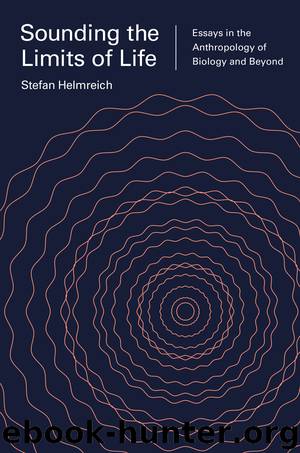Sounding the Limits of Life by Helmreich Stefan

Author:Helmreich, Stefan.
Language: eng
Format: epub
Publisher: Princeton University Press
Published: 2015-03-19T16:00:00+00:00
CHAPTER 12
SEASHELL SOUND
Shell of the bright sea-waves!
What is it, that we hear in thy sad moan?
Is this unceasing music all thine own?
Lute of the ocean-caves!
Or does some spirit dwell
In the deep windings of thy chambers dim,
Breathing forever, in its mournful hymn,
Of ocean’s anthem swell?
—Amelia Welby, “To a Sea-Shell,” 18451
FOR GENERATIONS, PEOPLE WHO LIVE by the sea have held that, when pressed to the ear, seashells sound with something like the roar of the ocean—a sound whose explanation has offered a pleasing and provocative puzzle to scientists and lay listeners alike.
In his 1915 Book of Wonders, the popular science writer Rudolph Bodmer suggested that the association followed from the symbolic power of shells: “The sounds we hear when we hold a sea shell to the ear are not really the sound of the sea waves. We have come to imagine that they are because they sound like the waves of the sea, and knowledge that the shell originally came from the sea helps us to this conclusion very easily.”2 But the likeness, he urged, had a technical explanation—though one in which similitude still figured. Both sea and seashell sounds were generated by waves: “The sounds we hear in the sea shell are really air waves”—waves, that is, of concentrated, resonant noise from the listener’s surroundings.
That explanation sought to supplant superstition with science, trading sublime enchantment for fascinating fact. The account in Bodmer’s book rested on a century of empirical and theoretical investigation in which sound had come to be understood as vibration, and not, as earlier, more numinously, on the model of music or voice, exampling what Jonathan Sterne names as a “shift from models of sound reproduction based on imitations of the mouth to models based on imitations of the ear.”3
Tune in a century later, however, and ear-centered explanations like Bodmer’s coil in on themselves; his explanation of seashell resonance (in agreement with scientific thinking then and now) loses out in most popular accounts to the erroneous claim that what we hear in seashells is the flow of our own blood. Jennifer Lawson’s 2001 Hands-On Science and Technology asserts, “Many students will tell you that they hear the ocean in the seashell. Actually, the dull roaring sound they hear is the echo of the blood moving inside their ear.”4 OMGFACTS.com—“the #1 fact source on Twitter” and a contemporary analogue, perhaps, to the Book of Wonders—offers, “When you put a seashell next to your ear, it’s the sound of your blood surging in your veins, not the ocean.”5 Oceanic other, sounded out, outs itself as inside noise.
Why this slide from the sound science of reverberating air to the sciency-sounding relay of blood? In 1889 Robert E. C. Stearns coined the term “ethno-conchology” to describe how shells have “been curiously interwoven with the affairs of men, both in civilized and barbarous communities.”6 I suggest that the changing ratios of ocean, air, and blood in seashell-sound accountings track a European-Atlantic-American ethno-conchology, one that unrolls from Romantic enthrallment toward a double-edged modernity that uses the language of science to disenchant at one moment and then reenchant at another.
Download
This site does not store any files on its server. We only index and link to content provided by other sites. Please contact the content providers to delete copyright contents if any and email us, we'll remove relevant links or contents immediately.
Sapiens: A Brief History of Humankind by Yuval Noah Harari(14311)
The Tidewater Tales by John Barth(12625)
Mastermind: How to Think Like Sherlock Holmes by Maria Konnikova(7274)
Do No Harm Stories of Life, Death and Brain Surgery by Henry Marsh(6904)
The Thirst by Nesbo Jo(6877)
Why We Sleep: Unlocking the Power of Sleep and Dreams by Matthew Walker(6651)
Life 3.0: Being Human in the Age of Artificial Intelligence by Tegmark Max(5506)
Sapiens by Yuval Noah Harari(5321)
The Longevity Diet by Valter Longo(5039)
The Body: A Guide for Occupants by Bill Bryson(5026)
The Rules Do Not Apply by Ariel Levy(4907)
The Immortal Life of Henrietta Lacks by Rebecca Skloot(4547)
Animal Frequency by Melissa Alvarez(4424)
Why We Sleep by Matthew Walker(4394)
The Hacking of the American Mind by Robert H. Lustig(4336)
Yoga Anatomy by Kaminoff Leslie(4331)
All Creatures Great and Small by James Herriot(4267)
Double Down (Diary of a Wimpy Kid Book 11) by Jeff Kinney(4239)
Embedded Programming with Modern C++ Cookbook by Igor Viarheichyk(4137)
